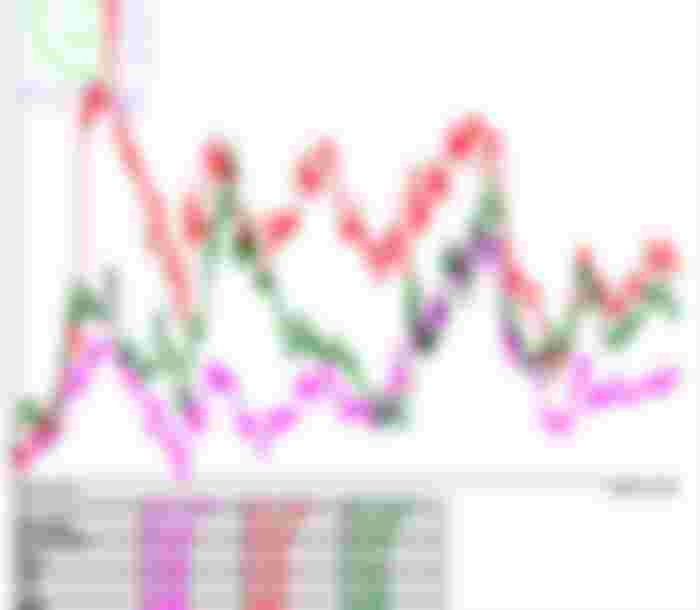We spend an inordinate amount of time on the MintDice Blog fixated on Bitcoin and other various cryptocurrencies and their underlying strategic benefits over government run fiat based currencies. But it's worth taking some time out of this cryptocurrency dominated field to take an honest look at which fiat currencies provide the most underlying utility and honesty to their native citizenry. For obvious reasons, since fiat currencies are run by governments and therefore people, the way fiat currencies are run and managed across the globe is far from equal. Many governments run extremely corrupt platforms. Some of the more infamous ones would be the Zimbabwean Dollar which hilariously had printed itself up to the $100 trillion dollar note before combusting. And with a more serious economy, how Argentina has been plagued by hyperinflation for decades on end with no sign of ever slowing down to this day.
On the other side of the equation, you have the world reserve currency types. Most notably, the four major fiat currencies, in order, are:
China / CNY, having roughly $33 Trillion in circulation
United States / USD, having roughly $18 Trillion in circulation
EUR / European Union, having rougly $16 Trillion in circulation
Japan / JPY, having roughly $14 Trillion in circulation
Following these four major fiat currency power houses, there's a huge drop in overall government fiat market capitalization. That's not to say that the fiat currencies that are off of this list are useless - they are not, and we'll get to a few examples soon enough.

One intrinsic problem with fiat currencies and the governing bodies that regulate their production and report their inflation numbers is that these same regulatory bodies are prone to lying. Most governmental agencies have a huge incentive to under report inflation numbers because a lot of government payout programs are pegged to any country's inflation numbers. And as a government that prints more money than it reports, it can start to deceitfully under pay on these programs to it's citizens. For example, in the United States, programs such as Social Security and Veteran's Benefits are pegged to inflation. Through under reporting of inflation numbers, the United States is able to effectively pay out less and less through these programs as the years clock on by.
However, through fiat currency conversion metrics which effectively show nothing more than the supply and demand comparisons over time can reveal the true nature of governmental influence on a relative basis. There will be some inherent bias towards inflation, whereby if all countries are printing at 5% per year, they will all move sideways together and not devalue relative to each other. But very obvious patterns when you compare countries that will start to emerge so that you can make some assumptions about the future. And when you combine these historical insights with somewhat blanket statement judgements about a country's infrastructure and overall stability, you can start to make reasonable enough predictions about some of the stronger fiat currencies for long-term holding.
Stable / Inflation Resistant Fiat Currency Overview
To look at the following charts that will be displayed below, if the ending position is higher than the initial starting position, then that means the leading (first) in the currency pair has gained value relative to it's counterpart which are denominated in the box below each graph. In the first chart, it will include only the first three major currency pairs, the USD, EUR and CNY:

The short side of the story between these three currencies is simply that there is not very much information that can be ultimately gained since they are fairly stable relative to one another. The USD has gained relative to the CNY by a fairly impressive 25%, but that is until you begin to realize that China does some pretty serious currency manipulation tactics to cheapen the price of it's goods for consumer export via inflation and currency pegs. Suffice to say, these three economic power houses we will use as the base line for studying further economies from here and call this the "normal" amount of inflation from these countries as their economies are fairly stable from shear size alone.
The next step from simply looking at these three currency pairs is to of course add Japan. Japan is one of the four major players when it comes to having a high economic fiat market cap. Let's take a look at it's chart:

Here, with this Japan / JPY chart, we can start to see some fairly obvious and clear patters now as the JPY starts to gain value over the course of time in a pretty markedly obvious and visible way which cannot be said for the other currencies relative to each other.
What this inherently means without drawing too many conclusions, one hypothesis could be that the supply of JPY hasn't increased as quickly as the other major economies which would allow one to infer that there is less inflation in Japan. The other would simply be that the economic output and demand for JPY has simply outpaced it's competition. More than likely, due to it's consistent nature of growth relative to these fiat counterparts, it's likely some combination of both factors. This is therefore one of our first conclusions of a more stable fiat currency that one could hold with potentially less risk of long term depreciation relative to other fiat holding candidates.
Next up, just for funsies, we'll take a look at a currency that we mocked earlier for having a reputation for being horrible, the Argentinian Peso / ARS. To see how quickly devalued a currency can deteriorate, look no further than this graph:

This graph is semi notable because unlike several other fiat currencies that have existed and been distributed over the modern era which devolved into nothingness, the Argentinian economy isn't completely terrible. Argentina is presently ranked as the 26th biggest economy by GDP in the world and yet they have a fiat currency that does nothing but destroy wealth for it's citizens year after year. When your country suffers from a currency that is this badly exploited by politicians and bad financial planning, several interesting (bad) outcomes happen for it's population. Notably excess spending and capital flight.
When countries, like Argentina, have hyperinflation, weird things happen. In "normal economies" such as the CNY, USD and EUR that we've been looking at so far with "standard inflation" rates, often times saving and investing money can make practical sense for individuals. Not so in Argentina. Normal consumer goods can actually appreciate relative to their currency. For example, a luxury car that would lose a lot of value in the United States or Europe as the years tick by would actually be gaining value over time relative to the ARS. Thus, a lot of people will buy such things leading to an excess of consumer spending leading to an unstable economy. Furthermore, those that do wish to save money, will often times have to go to foreign exchange black markets to trade out their currency for Uruguayan Pesos or other such currencies that are more stable to preserve their capital (one of the main focuses of this entire article).
Of stable economies on the western hemisphere, there's one country in particular that has a very strong GDP and tends to show very predictable solid growth over time. This is from the country of Switzerland which uses the Swiss Franc / CHF.

Looking at the standard economies with the USD, CNY and EUR we can see the clear pattern of growth due to it's cautious use of fiat monetary printing. Also used here is the JPY as a bench mark for a solid economy as we first mentioned. While the CHF is slightly beating the JPY we can see this is likely more just a mild fluctuation in the margin of error and that these countries are effectively equal to each other over the modern era.
Switzerland does face some problems with the fact that it's currency continues to appreciate over time. This has one unfortunate consequence of making Switzerland's goods and services extremely expensive in Europe and else making it difficult for other neighboring countries to do business with Switzerland. It also creates an artificially high demand on Swiss citizens to want to purchase goods from neighboring countries, in effect making their own country miss out on some domestic value.
Of final note to take a look at is Singapore:

Singapore is an extremely high quality of living and high cost of living country. No different than Switzerland or Japan. All of these countries with a strong, inflation-resistant fiat currency do seem to have a few major things in common:
Smaller sized country
Very high IQ citizenry
Respectable cultures
Very high level of country infrastructure
Relatively autonomous and self-sufficient
Thus, it seems like if you have cultures that are small and proper enough, that good things really can happen. You can create beautiful cultures across the globe, that among other things, also suffer from less government corruption which can also be seen in the form of less inflationary money printing, which won't devalue your hard earned money quite as quickly.
Stable Fiat Diversification
Again, we are very large Bitcoin bulls and cryptocurrency bulls in the MintDice sphere. We know a lot of our readers are too. And as much as it is important to own some reasonable percentage of one's net worth inside of Bitcoin or other cryptocurrencies, holding anywhere even near a full 100% is likely neither smart nor convenient for interacting in the real world. Fiat clearly has some advantages, for now at least. And one could argue that no single reason for fiat is more important than either having an increased amount of financial stability or simple retail consumer acceptance.
Retail / consumer acceptance is a very simple problem to deal with for any individual. Simply own some amount of the native currency in the country of which you are operating to deal with things on a day to day basis relative to your cost of living. No big surprises here. But on the spectrum of long term financial stability, this can lead to broader decision making that you may be interested in learning about. We're not saying to completely ditch the CNY (minus the Chinese capital controls), USD or EUR, as they are major economies. And being a part of fiat currencies that are part of the world's biggest economies will by nature be able to absorb bigger shocks and have a bigger buffer to unforeseen events.

But that said, if you are looking to diversify your fiat holdings across other pairings besides the USD, EUR or CNY, we'd suggest that you choose some of the fiat currencies that we have suggested in this article. You can use your best judgement too. If you are more bullish on the Asian or European side of the equation then you can lean more favorably to CHF or SGD/JPY. Alternatively, if you simply have easier access to certain currencies over others depending on your background or banking potential, that is a different decision all on itself determined more on a case by case basis.
Of course, make sure that you are able to take these foreign currencies and invest them into their local stock exchanges, like the Swiss stock exchange or other such investible assets to lead to long term capital growth and very importantly, stable growth. Leave the risky growth side of your portfolio to Bitcoin, cryptocurrency or other private equity investments to really help you moon your monetary portfolio without needing to subject yourself to unnecessary and overwhelming financial shocks.
We said it before and we'll say it again, it's important to achieve growth through Bitcoin and cryptocurrency but you also need to make sure that you have some safer assets as well so that your risk of ruin doesn't ever get too high by being over leveraged in the wrong asset class.
Invest wisely!
This article was brought to you by the MintDice Provably Fair Bitcoin Casino. Originally posted on MintDice.com.







let's visit my article